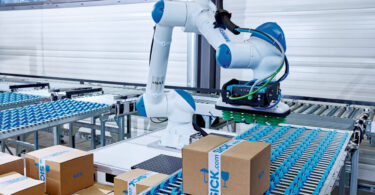How this technology will change the game for automation and production efficiency in industry
Deep learning and artificial intelligence in manufacturing is here and machines will perform tasks that require human intelligence. As the digitalization of processes and data capturing in companies increases, so too will the use of Deep Learning, which will allow a more effective collaboration between humans and machines, completely revolutionizing automation and production. This will lead to more efficient and precise decision-making processes, higher productivity, and will significantly lower development costs.
In our “SICKnificant” podcast, we spoke to Dr. Christoph Eichhorn, Strategic Product Manager for Digital Services and Solutions at SICK AG, about the potential of deep learning to relieve humans of tiring tasks and to increase quality.

Dr. Christoph Eichhorn, Strategic Product Manager for Digital Services and Solutions at SICK.
Deep learning, as a subset of artificial intelligence and machine learning, has been gaining importance in recent years due to increased availability of data and computing power. The technology is revolutionizing automation in production and other areas, enabling machines to perform tasks that previously required human intelligence.
“Deep learning is a subset of machine learning. It uses artificial neural networks, so-called “deep neural networks”, that can manage even complex situations. They can perform complicated decision-making processes and allow companies to automate and digitalize more processes. By doing so, they are raising the efficiency in production to a new level,” Eichhorn said.
Digitalization and artificial intelligence in manufacturing

The concept of digitalization in industries has advanced enormously in recent years. Data from sensors and other sources that have previously been used for immediate process control are stored as part of the digitalization, and thereby available on a more abstract level. Collecting the data is not sufficient. Artificial intelligence in manufacturing plays an important role when it comes to extracting the essence from data, which can lead to further optimization.
In the timber industry, several gigabytes of training data were used to train a neural network that can make decisions more accurately, quickly, and untiringly than possible with the human eye. This network is smaller than one megabyte but nevertheless has access to a wealth of experience and can be applied to an arbitrary number of applications.
Added value of AI-based automation
Artificial intelligence doesn’t always require a large volume of data. The implementation of deep learning projects varies greatly and depends on the specific customer requirements. Formulating this requirement and expectation is not always easy but is a prerequisite for successfully employing artificial intelligence. “Put simply: you can only get the desired result using AI if you know what you want. Once that has been clarified, customers can expect to obtain a simple and flexible solution for their problem,” said Eichhorn.
“Thanks to AI, our customers can automate for themselves tasks that in the past were extremely difficult to automate. Good examples of this are quality and assembly control for reflective parts, checking solder joints, or sorting natural products. These are usually laborious tasks that use up a lot of the value time of qualified personnel and can therefore often only be performed by sampling.”
Training of artificial neural networks
The use of deep learning can bring about a paradigm shift in automation. Instead of determining what details are relevant for a decision and then applying a series of specific rules, it uses examples. The algorithm independently learns to make decisions.
“We train a solution, rather than programming it, which is significantly faster and more efficient. It is important to emphasize, however, that deep learning is not an alternative to human expertise. This will remain necessary to exploit the full potential of the technology. Deep learning supports and extends human capabilities,” explained Eichhorn. “Thanks to our easy-to-use deep learning tools, users familiar with a problem will be able to solve it independently even without deeper programming knowledge. Because only they know what matters for the solution – and what doesn’t – and are better able to select suitable training examples than anyone else. With our tools, you can start training an artificial intelligence intuitively and thereby solve an extremely specific and individual task.”





